September 4, 2024. What have the return-to-office trends looked like this year?
A few months into the pandemic, people began seriously questioning whether remote work would last forever. Some proclaimed that people would never go back to offices, citing employee preferences and productivity increases based on remote work in 2020. Remote work also brought tangible benefits to employers, such as the ability to recruit talent nationally or even globally, not to mention cost savings on office space.
Others observed that while individual jobs could be performed well remotely, companies as a whole were becoming less dynamic and more siloed. Employees were feeling disconnected from their peers, leading to a decline in collaboration and a reduction in institutional knowledge which would negatively impact performance. Although fully remote work policies brought tangible benefits to employees and to companies, they also brought new problems (and new vocabulary) like “Zoom fatigue,” “job stacking,” and “quiet quitting.”
Already, in 2020, many companies suggested hybrid work as part of the Goldilocks scenario. Companies could balance the efficiency and employee satisfaction that come from working from home sometimes, with the better communication, collaboration, and knowledge sharing that come from working in person. While some companies continued to espouse fully remote work or 5 days a week in person, the majority of companies looked to hybrid work as the answer. Debates raged between employers and employees and between pundits over what hybrid work would look like and whether it would succeed or fail.
Since 2015, Bevi has been building a database of workplace attendance by region and by industry. This gives us a unique view of office life throughout the pandemic and its aftermath. While the RTO debate raged over the past four years, the actual level of workplace attendance has gradually – but consistently and unmistakably – risen. In 2023 we had assumed we were finally near an equilibrium in hybrid work, with people coming to the office ~2.7 days per week, but in fact, we’ve seen workplace attendance increase even more in 2024, to an average of over 3.0 days per week (and still climbing).
Although hybrid work has taken root, in 2024 it is gradually resembling more and more of a 5-day work week, with attendance increasing on Mondays and Fridays relative to 2023 (though still comparatively light on those days relative to 2019). That said, the traditional 9-5 workday does appear to have gone away; although on average employees commute fewer days per week, our data shows that when they do go into the office, they work longer and fewer standard hours.
I’m excited to see how hybrid work continues to evolve, but one thing is clear from the data: most companies see significant value in spending time together in person.
Bevi Co-founder, Sean Grundy
Findings in this report:
- Return to office trends may exceed 2023 predictions
- We’re seeing more in-person attendance for all industries—except one
- Los Angeles and Boston are leading the return to the office
- Tuesday is still the busiest day in the office after the pandemic
- The shift away from 9-to-5 workdays continues
- What’s Powering AI? More Consistent Time in the Office Than Other Tech Companies
1. Return to office trends may exceed 2023 predictions
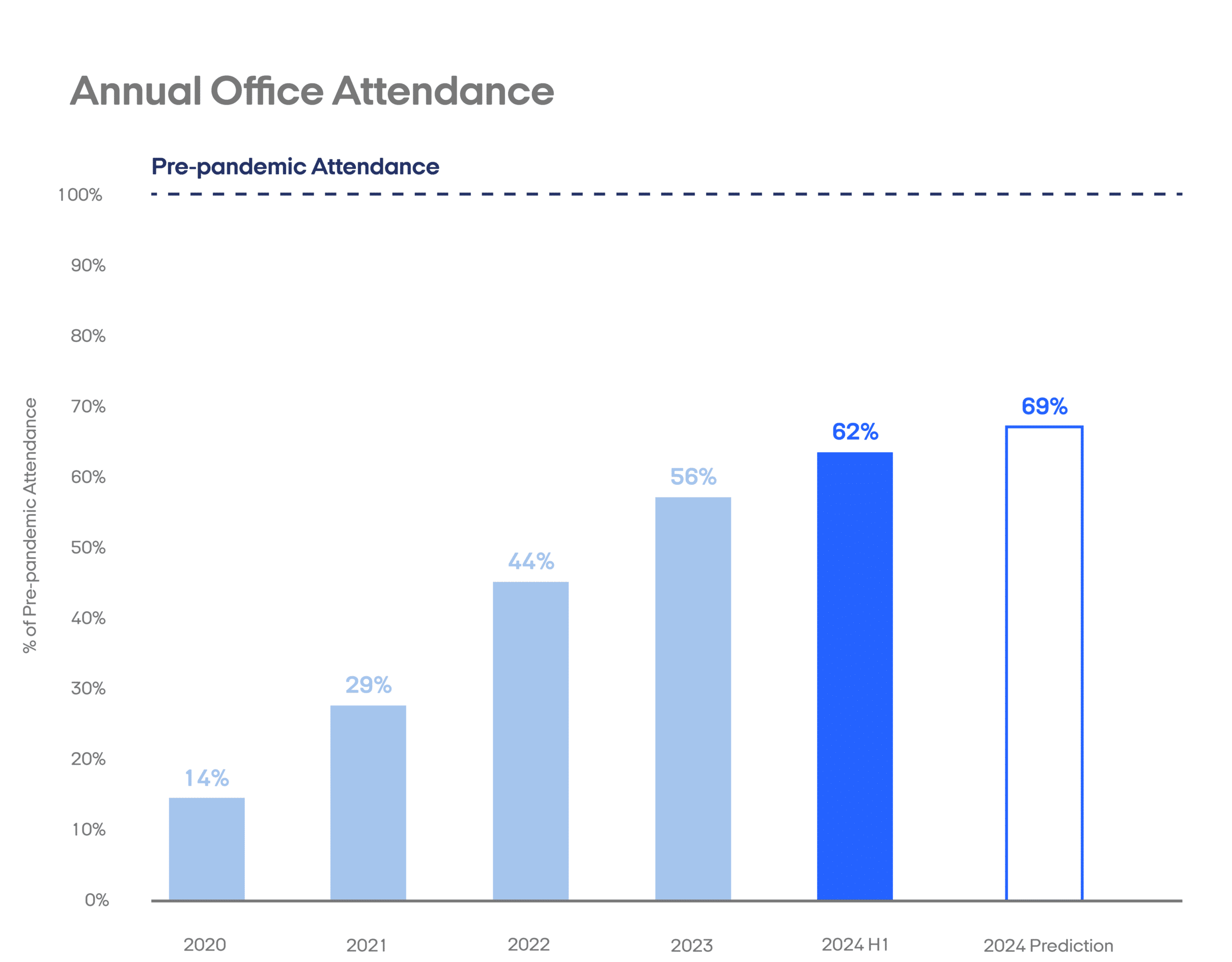
Ahead of previous predictions. At the start of 2024, Bevi predicted that office attendance would reach 64% of its pre-pandemic level by the end of this year. Data shows we are nearing that prediction, currently trending at 62% of average 2019 in-office attendance, as of July 2024.
What’s next? Office attendance will continue to bounce back this year, outpacing our previous expectations given dispense data trends from our internet-connected water coolers. While we initially forecasted 9% growth in office attendance from last year to this year, we now anticipate surpassing that by 5 percentage points, reaching 69% of pre-pandemic attendance by the end of 2024.
Behind the numbers. Our projection came from looking closely at aggregate usage data from our Smart Water Coolers®, which are found in thousands of offices across all 50 states. We estimate office attendance by tracking water consumption, which tends to mirror time spent by employees in the office. By aligning each month’s data with the corresponding month in 2019, we account for drinking habits in a consistent, seasonal way. This method allows us to accurately gauge shifts in office attendance since the pandemic, focusing on overall trends while ensuring individual company data remains confidential.
2. We’re seeing more in-person attendance for all industries—except one
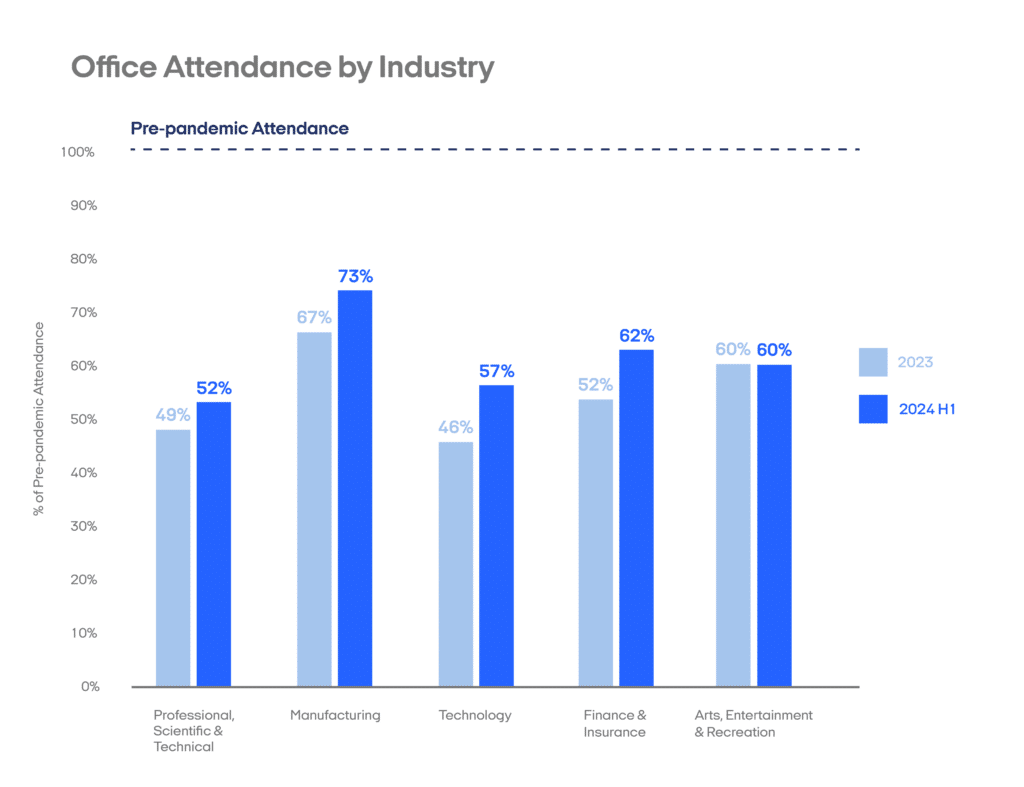
Slow but steady. Out of the five industries we tracked, four saw increases in office attendance this year compared to last. Some industries experienced significant gains, with the technology sector showing an 11 percentage point spike in return to office trends.
Of note: now, all major industries are at more than half of 2019 pre-pandemic attendance levels.
One, and only one sector—arts, entertainment, and recreation—saw no difference in office attendance between this year and last, indicating that they may have found a new equilibrium with attendance three days per week.
Importantly, no industry is seeing less in-person attendance in 2024 than they saw in 2023—and almost all of them are seeing significantly more.
3. Los Angeles and Boston are leading the return to the office
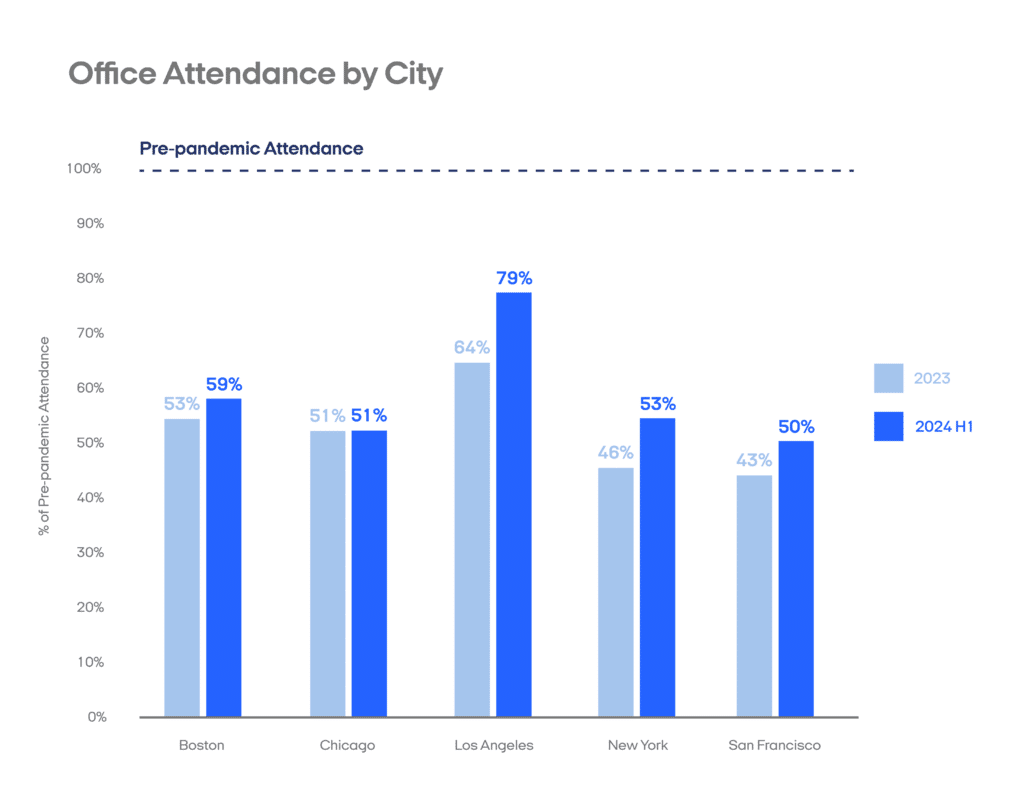
I’m goin’ through changes. Los Angeles is seeing a rise in office attendance for multiple reasons, including California’s new hybrid work policy for state employees, which requires over 240,000 workers across the Golden State to now be in the office at least two days a week. (It’s a push that should help to bolster local economies, but not everyone is happy about it.) This jump continues a return to office trend from October of 2020 when Los Angeles employees began to trickle back into the office even as remote work dominated.
Busy in Beantown. Boston continues to outpace New York City, San Francisco, and Chicago in office attendance. This trend is supported by other foot traffic data and highlights Boston’s success in integrating in-person collaboration with effective hybrid work strategies, according to the Boston Business Journal.
Boston stands out in adapting to the future of work due to its many mixed-use developments, which have been a key focus of the city’s urban planning for over a decade. Neighborhoods such as Back Bay, Seaport, Charlestown, and South Boston blend residential, dining, and retail spaces, creating the opportunity for work-life balance close to where people actually work.
4. Tuesday is still the busiest day in the office after the pandemic

Same coordinates but a different place. We’re getting closer to pre-pandemic office attendance levels, but the workweek definitely looks different for almost everyone. While attendance is increasing on Mondays and Fridays, the middle stretch of Tuesday, Wednesday, and Thursday is still the most popular time for employees to be in the office.
Companies are still experimenting with mandates as a way to better balance how full the office is over the course of the week. Deutsche Bank, for example, now requires employees to be in the office on Fridays and Mondays as part of their time in-office.
While Mondays are making a comeback, Fridays still pose a challenge for getting people back to their desks. In early 2024, Friday attendance saw the smallest increase compared to last year. For many, Fridays have now been solidified as a relaxed, low-key day—a chance to ease into the weekend by working at their own pace, often from the comfort of their own home. That’s a return to office trend that’s not going away any time soon.
5. The shift away from 9-to-5 workdays continues

Traditional workdays are yesterday’s vibe. Although overall office attendance has increased since 2023, our adherence to the traditional 9-to-5 schedule has continued to decline. In 2024, 20% of office attendance occurs outside of these standard hours, compared to just 13% pre-pandemic.
This change marks the start of a shift away from the rigid 9-to-5 work schedule. As employees adapt to hybrid work—and gradually return to the office more frequently—the timing of when people actually show up will be different from pre-pandemic times.
With hybrid work, there’s more flexibility to manage everyday life, whether it’s avoiding rush hour, handling family duties, running errands, or making use of the office during quieter evening hours.
For many employees, this will mean showing up to the office later. Over half of adults naturally go to bed after midnight, so a standard workday was something always out of sync with many people’s internal clocks. Now, they can work when they’re most focused and inspired, leading to better quality work and less burnout. That’s a win-win return to office trend for employers and their employees, and a key reason to believe the amount of work happening outside of traditional hours will go up another two or three percentage points in 2025.
6. What’s Powering AI? More Consistent Time in the Office Than Other Tech Companies
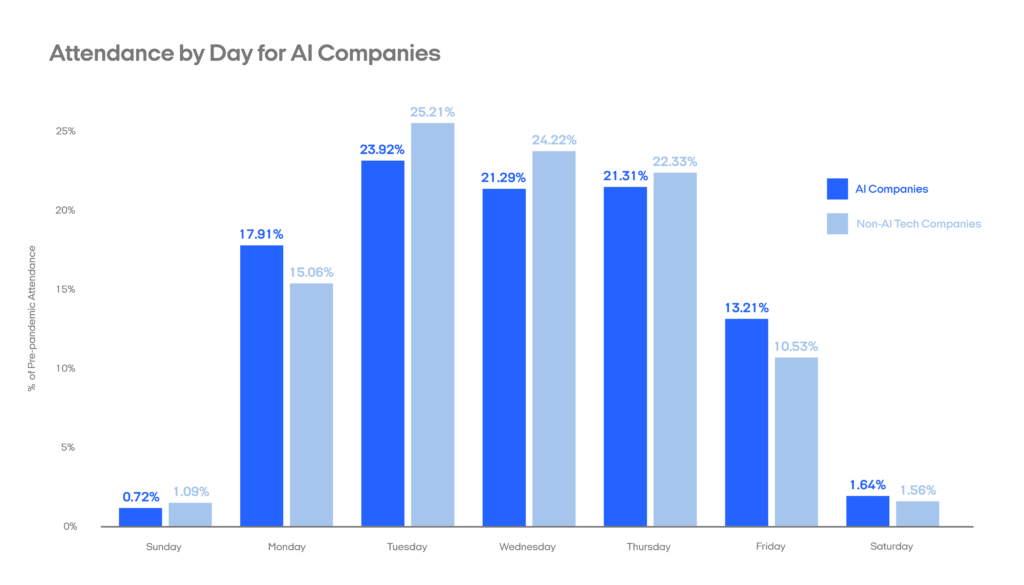
Office attendance at AI companies generally follows similar patterns to other tech firms, but AI workers show a more balanced presence throughout the week, with higher attendance on Mondays and Fridays.
Apparently, the most innovative, fastest paced, and highest-tech industry still values old-fashioned in-person work. AI still needs humans!
Bevi survey of 1,000 U.S. employees reveals what’s really distracting workers today – and inspires the launch of Focus Blend, a clean, customizable enhancement.
BOSTON, MA., September, 2025 – Americans are more distracted now than ever before. Constant notifications, endless social media feeds, and a 24/7 news cycle all pull our attention in different directions every day, especially at work. To dig deeper into the challenges people face when trying to focus at work, Bevi asked 1,000 employees across various U.S. industries what helps – and what hurts – their ability to concentrate during the workday. The results reveal not only the biggest productivity disruptors, but also how they vary by generation.
Survey Results
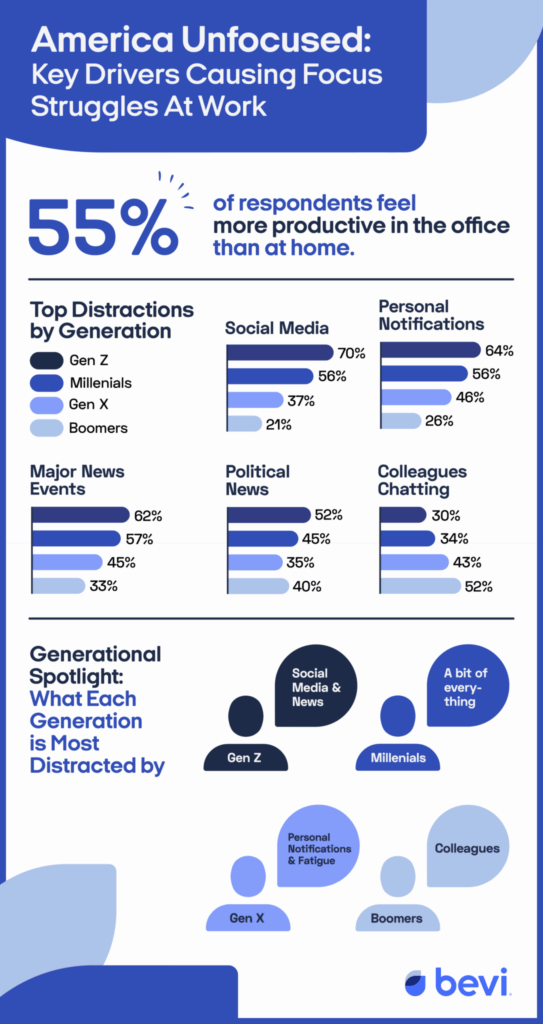
Other Key Callouts:
- 45.9% of respondents said they only somewhat understood how certain vitamins, minerals, or nutrients in the food and beverages they consume can impact their ability to focus at work.
- Only 16.8% rated the support provided by their team or organization in helping them stay focused and productive as “excellent.”
- 72.2% answered “yes” when asked if they would try a beverage designed to help improve their focus.
While nearly half (45.9%) said they somewhat understand how nutrients can impact focus, many admitted they were confused and eager to learn more. With 72.2% expressing interest in a focus-enhancing beverage, Focus Blend was designed to close that gap – offering a simple, customizable way to stay sharp whether in offices, schools, healthcare facilities, or anywhere focus matters.
“The functional beverage category is one of the fastest-growing in the industry, projected to surge from $153 billion in 2024 to more than $232 billion by 2032 – and our survey shows nearly three-quarters of employees want a drink that helps them focus,” said Cathy Lewenberg, CEO at Bevi. “With Focus Blend, we’re addressing that need head-on, offering a clean, customizable way to stay sharp.”

Focus Blend, Bevi’s first-ever enhancement designed to deliver calm, lasting focus without the high caffeine of traditional energy drinks, is available exclusively from Bevi’s Smart Water Coolers®. Hydration in general is key to maintaining optimal brain health, as even mild dehydration can impact cognitive abilities, and Focus Blend is taking hydration to the next level. Naturally sourced from green coffee beans and paired with L-theanine to promote a calm, focused mind, B12 to support brain health, and magnesium to aid nerve function, it’s the perfect addition to your hydration routine. Just like other Bevi enhancements, users can add Focus Blend to still or sparkling water, plain or flavored. Unlike traditional energy drinks or a strong cup of coffee, Focus Blend delivers a gentle lift at 20 mg (low), a balanced bump at 40 mg (medium), or a more energized option at 60 mg (high) per 12 oz. With zero sugar, zero calories, and no added flavors or colors, Focus Blend is a wellness-forward functional enhancement designed for everyday use.
The survey findings make clear: people want beverages that not only taste great but help them perform their best – exactly what Focus Blend was designed to deliver. To learn more, visit bevi.co/get-a-quote/.
FAQS
What is Focus Blend?
Focus Blend is a lightly caffeinated, functional beverage designed for clarity and a calm focus effect without feeling wired. It’s our newest enhancement designed to help you stay sharp and feel energized, without a high dose of caffeine.
What makes Focus Blend different from coffee or energy drinks?
Unlike traditional energy drinks or strong coffee, Focus Blend uses:
● Low-dose, natural caffeine from green coffee beans
● B vitamins and magnesium for brain support
● L-theanine to smooth out energy and support focus
Can it be combined with other flavors or enhancements?
Absolutely! It pairs well with all flavor concentrates and can be combined with Vitamin Boost or Electrolytes.
What does Focus Blend taste like?
Focus Blend does not have a strong taste or smell. Perfect to have on its own with water or paired with your favorite flavor.
How much caffeine is in Focus Blend?
Focus Blend contains a gentle amount of caffeine, similar to a cup of green or black tea—perfect for a subtle lift without feeling wired. Focus Blend has a three position slider for: standard strength, lower strength, and higher strength. The caffeine content per 12oz serving: 20mg (lower setting), 40mg (default), 60mg (higher setting).
Where does the caffeine come from?
The caffeine is naturally sourced from green coffee beans.
How does Focus Blend work?
Focus Blend is formulated using ingredients that have been studied for their effects on energy, focus, and mood. B vitamins, magnesium, and L-theanine, are widely researched as supporting brain function and balanced energy.
Will I feel an effect?
While individual experiences may vary, the majority of participants in our trial reported feeling a noticeable effect after drinking Focus Blend. Of those who noticed a difference, 75% said they felt more focused or energized.
When should I use Focus Blend?
Anytime you need a mental refresh: during an afternoon slump, while working, studying, or after a long meeting. It’s designed to help you feel calmly alert, not hyper.
Will it make me feel wired later?
Nope! Focus Blend is designed for a smooth, lasting focus. The combination of L-theanine and low-dose caffeine supports focus and calm, while avoiding feeling wired.
Is it safe to use daily?
Yes, but those with an underlying health condition should seek the advice of their healthcare professional! Focus Blend uses safe, food-grade ingredients that are commonly found in supplements and beverages.
Can Focus Blend and Energy Boost both be in one Bevi machine?
Yes, you can install both beverage options side by side in a Bevi machine! The caffeine counter will tell consumers how much caffeine they put in each drink.
What makes Focus Blend different from coffee, energy drinks, or Bevi’s Energy Boost?
Bevi’s Energy Boost delivers more caffeine for a faster and greater energizing effect. Focus Blend on the other hand is designed to provide a more balanced effect.
When will Focus Blend be available?
Focus Blend will become available for purchase in September 2025.
Where will Focus Blend be available?
Focus Blend will only be available in the US at this time.
What if I have other questions?
Please forward any other questions to focus@bevi.co.
Last updated April 25, 2025.
How the biggest drink brands got their start and the new beverage innovations trying to take them down.
At Bevi, we believe beverages are more than the bottles they come in.
They keep us healthy and hydrated, satisfy our cravings, and bring us together. A morning coffee. An afternoon water cooler break. An evening drink. The single-use bottle they come in might be a complete waste, but how these beverages are formulated speaks to our unique experiences, cultures, and preferences.
In the process of shaping what we drink, the brands behind these popular beverages shape how we see ourselves. That is why we’re exploring the rise of today’s most iconic drink brands, from fast-food cult classics to punk-rock canned water, in this Bevi editorial series.
As we detail their stories, we hope to inspire you to think more deeply about the choices you make at the fridge and the checkout counter. Or, at the very least, we hope you recognize how the iconic beverage you’re buying came to be.
Latest drink brands coverage
History of Starry soda and other lemon-lime sodas // Sprite has led the lemon-lime soda category for decades. What shot does Starry soda have at dethroning the king?
Poppi vs. OLIPOP: The rapid rise of better-for-you soda // Poppi soda and OLIPOP started as small-scale experiments. How did they make off with a soda category long dominated by Big Beverage?
Have a drink brand you’d like to see us profile? Send your ideas to hello@bevi.co and we’ll follow up if it looks like the right fit for this series.
Last update April 23, 2025.
Bevi’s Vitamin Boost is packed with essential vitamins and minerals for your immune system.*

Why do customers love Vitamin Boost?
- Functional energy. Packed with an essential blend of Vitamin C, B Vitamins, and Zinc.
- Clean living. Zero sugar. Zero calories. Full benefits. No artificial flavors or colors.
- Goes with anything. Craft your perfect drink for any time of day by combining Vitamin Boost with any of our 16 other flavors and enhancements.
*These statements have not been evaluated by the Food and Drug Administration. These products are not intended to diagnose, treat, cure, or prevent any disease.
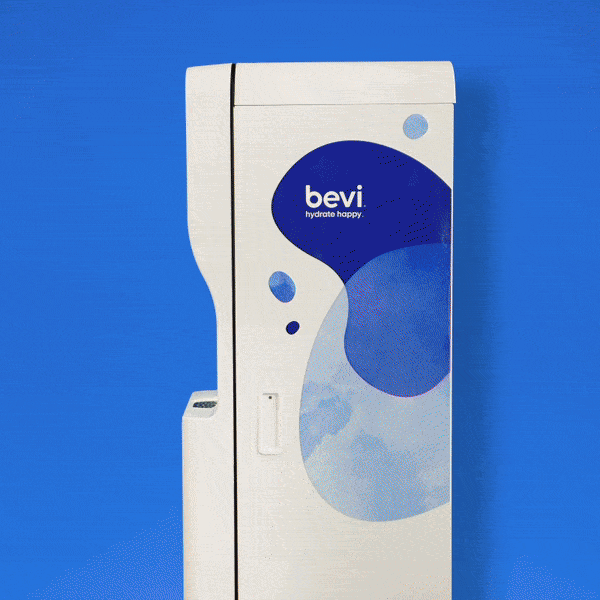
FAQs
What can you combine this enhancement with in a Bevi machine?
Vitamin Boost is calorie- and sugar-free, with only a subtle, mineral-like taste, which means it mixes well with any other flavors or enhancements that you’re selecting on the Bevi machine. Customers especially enjoy mixing Vitamin Boost with citrus-based flavors, like Lemon and Lime Mint, which inspired us to come up with the seasonal beverage Super Orange, available for a limited time only.
When should you drink Vitamin Boost?
If you’re looking to support your immune system and overall health, whether it’s flu season or you’re just feeling a bit sluggish, Vitamin Boost can be mixed into any beverage you pour from a Bevi machine.
How much of this enhancement is safe to drink from a Bevi machine?
Vitamin Boost is formulated with several vitamins and minerals, including Vitamin C, B-12, and Zinc, to be consumed multiple times throughout the day without worrying about overdoing it.
Are there preservatives in Bevi’s concentrates?
Our flavor and enhancement concentrates include potassium sorbate—one of the most common preservatives used in food and beverage.
What third-party certifications does Bevi have for Vitamin Boost?
Vitamin Boost is vegan and therefore doesn’t contain animal products. It’s also sodium-free, gluten-free, and kosher certified.
Learn about Bevi’s other functional enhancements
Read the latest on Bevi’s blog
- America Unfocused: Focus Struggles at Work Inspire Bevi to Launch Focus Blend
- Blog series: The rise of today’s iconic drink brands
- Vitamin Boost: Our most popular enhancement
- Every bottle counts: Beverage industry impact report
- These London-based companies love their Bevi machines
- Owala water bottle vs. Stanley Quencher: Choosing the best stainless steel water bottle
- Poppi vs. OLIPOP: The rapid rise of better-for-you soda
- Is flavored water good for you?
- Is there bottled water without microplastics?
- 9 perks at work for a great culture
- Does reverse osmosis remove microplastics?
- Allulose 101: A curious alternative sweetener
- Coffee badging meaning: What do businesses need to know?
- There’s PFAS in your bottled sparkling water
Last updated April 22, 2025.
A minute from now, another million plastic bottles of water will have been sold all over the world. Are you buying?
The vast majority of these plastic water bottles will be used only once. Most won’t be recycled. Instead, they’ll be incinerated or forgotten—piling up in landfills, clogging rivers, washing into oceans. And over time, they’ll break down into microplastics that are now showing up inside the human body.
Despite mounting evidence of the environmental and health risks, plastic bottled water sales keep climbing. Why?
- Most people don’t realize how much plastic they’re actually drinking.
- Research into what microplastics do to our health is only just beginning.
- Plastic bottles are cheap to make and easy to move.
- Brands build their identity on single-use packaging.
- Recycling efforts provide just enough cover to keep the system going.
This report was written to show exactly how every bottle counts. It lays out how plastic bottles are made, where they end up, and what they’re doing to our environment and our bodies. It also shows what the alternative looks like when you eliminate the bottle entirely.
What’s below:
- How much bottled plastic the beverage industry is selling
- Why recycling doesn’t come close to solving the problem
- What plastic bottles are doing to the environment
- How plastic packaging is contaminating the drinking water it’s supposed to deliver
There’s already a better way
Bevi machines filter your water to make it the kind of beverage you actually want to drink. Sparkling or still, flavored or plain, cold or room temperature, with or without functional ingredients. No single-use plastic bottles. Just the best water you’ve ever tasted.
Removing plastic, inside and out. Bevi machines not only eliminate the need for a single-use bottle, but also the risk of plastic in your drinking water. They are equipped with advanced filtration that removes 99.9% of microplastics and other common contaminants.*
*when using the recommended 3M HF20-i carbon filter.
An industry built on waste
Since plastic bottles began replacing glass in the 1970s, the beverage industry has built its entire supply chain around cheap, lightweight plastic.
- 600 billion plastic bottles are produced each year for water alone.
- 15.9 billion gallons of bottled water were sold in the United States in 2023.
- By 2050, we’re on track to produce 2.4 trillion pounds of plastic annually.
From manufacturing to transport to disposal, plastic bottles waste energy and create emissions. And once discarded, they become long-term pollutants, whether intact or as microplastics.
The recycling excuse
Ask most beverage brands about their plastic environmental impact, and they’ll point to ambitious recycling goals.
- Coke: By 2035, Coca-Cola aims to collect the equivalent of 75% of the bottles and cans it puts into the market each year in order to recycle them.
- Pepsi: By this year, Pepsi is looking to have 100% of its packaging be recyclable, compostable, biodegradable, or reusable.
- Nestlé: By the end of this year, Nestlé is looking to have 95% of its plastic packaging designed for recycling.
These efforts sound promising. But recycling doesn’t scale nearly fast enough to keep up with this much plastic production. Plus, if companies are not reducing the amount of plastic they’re making in the first place, there’s no reason to think recycling will change anything for our planet or for our health.
These efforts are only worth it if there’s follow through. Coca-Cola, for example, previously pledged to recycle 100% of the equivalent number of bottles and cans it put out into the market each year, then revised it down to 75% last December. They also pledged to make 25% of their bottles returnable or refillable by 2030, but that commitment was quietly removed from the company’s website years later.
Is recycling important, even necessary? Absolutely. A successful circular economy requires us to have the capacity to recycle. But recycling is often used as a distraction. An action that sounds like a solution but mostly provides good press and enough cover to keep single-use production going.
Recycling isn’t the answer. It’s stopping the production of single-use plastic bottles altogether.
- Just 32% of U.S. trash is recycled or composted.
- Only 9% of all plastic ever produced has been recycled.
- Even PET bottles—widely seen as highly recyclable—had a 33% recycling rate in 2023. The other 67% ended up in landfills, incinerators, waterways, or our oceanas that year.
Leakage is inherent to the system. No matter how much we recycle, plastic waste continues to escape into the environment.
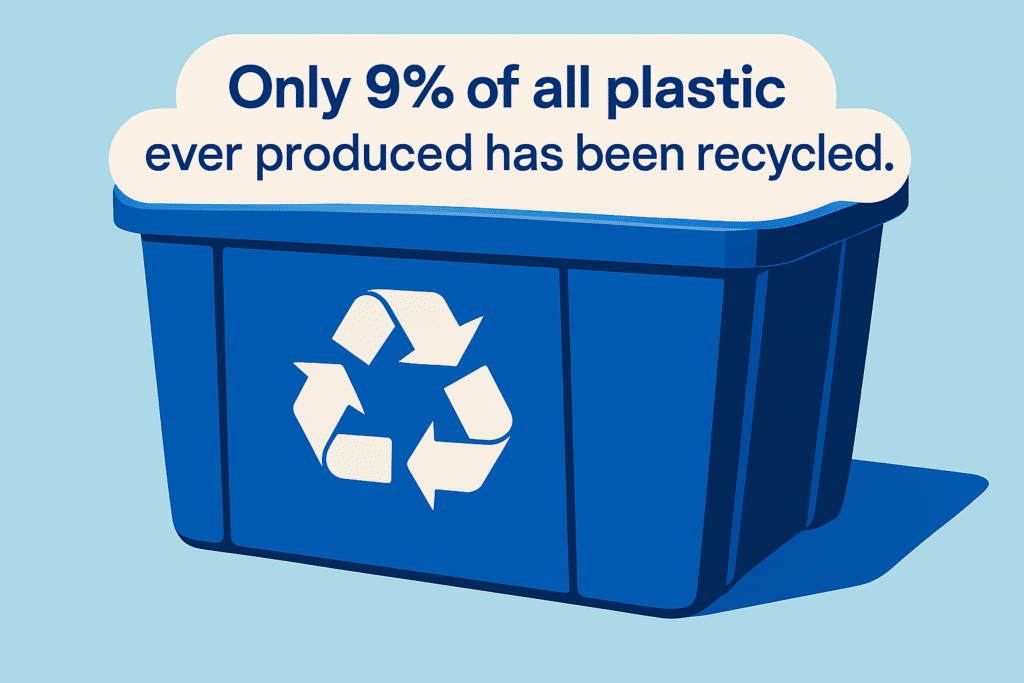
What it takes to produce plastic bottles
Beyond the sheer volume of plastic waste added to the environment, plastic bottles are also remarkably resource-intensive to produce, transport, and refrigerate.
- Producing one liter of bottled water requires three liters of water.
- It takes up to 2,000 times more energy to produce and transport bottled water compared to a similar volume of tap water.
- One bottle generates roughly 83g of carbon dioxide emissions from factory to fridge.
All of this effort and expenditure for water you likely already have access to on tap.
How big is the plastic pollution problem?
Despite recycling initiatives, plastic bottles continue to flood the environment:
- 33 billion pounds of plastic enter marine ecosystems every year.
- Beverage containers make up 12% of waste entering our oceans, nearly 4 billion pounds annually.
- Each plastic water bottle takes at least 400 years to degrade once it’s in the ocean.
- Plastic in a landfill can take far longer to break down, with some items, such as plastic bags, estimated to last up to 1,000 years.
At least 267 species—from sea turtles to seabirds—are affected by plastic waste through entanglement, ingestion, suffocation, and more.
The plastic we’re drinking
- 93% of bottled waters tested contained microplastics, at levels double that of tap water.
- A single plastic bottle can contain 240,000 microplastic particles.
- This finding represents a tenfold to hundredfold increase compared to previous estimates, which primarily focused on larger microplastic particles.
All of the plastic that is dumped into our ocean becomes part of the water we drink. But the problem truly starts with the bottle of water itself. The material of the plastic bottle itself degrades over time, especially when subjected to physical stresses like squeezing or exposure to heat, leading to the release of microplastics into the liquid.
Microplastics can also be introduced during the manufacturing processes, including the handling of plastic materials in the bottling plants and the use of plastic components in the equipment. The duration of time that a beverage spends in its plastic packaging, both during processing and storage, can also influence the extent to which microplastics leach into the liquid.
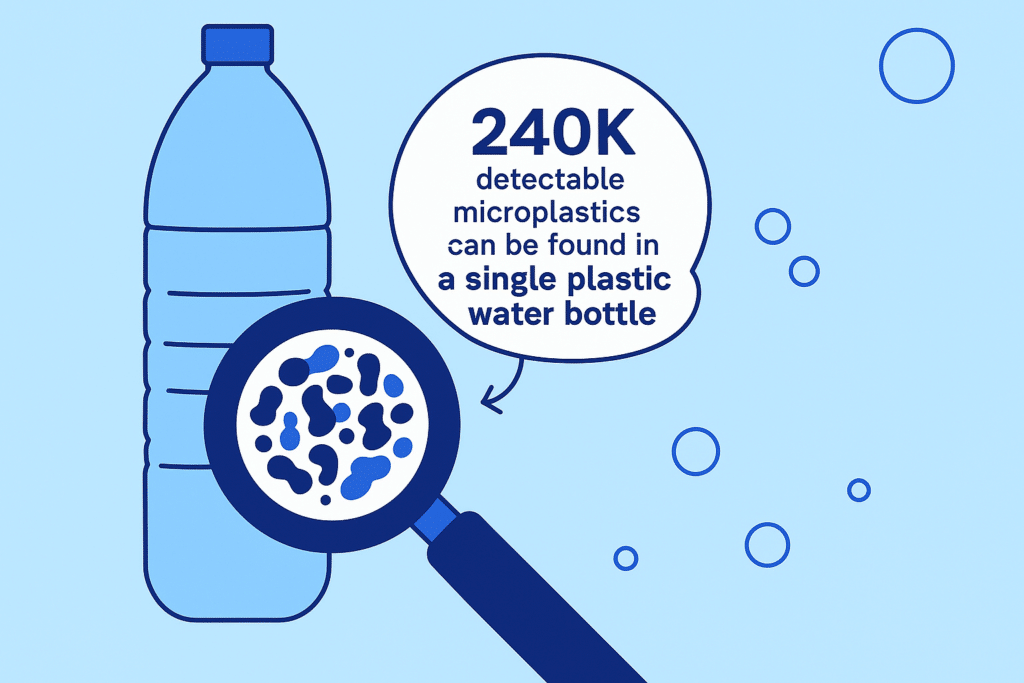
It doesn’t have to be this way
All of this plastic waste, all of this energy and capital, comes down to one word: unnecessary.
Most places already have access to tap water. For places that don’t, getting clean water delivered at scale should be the goal, not bottling it up, branding it, and shipping it around the world.
If we’re lucky enough to have water at the tap, we should be focused on filtering it and making it enjoyable to drink—whether that means adding fizz, flavor, or functional enhancements.
You’re better off drinking filtered tap water than anything that comes in plastic. So is the planet. So are the ocean’s ecosystems. A generation from now, bottled water will seem as outdated as smoking on airplanes or not wearing seatbelts. Kids will come home and ask if we really used to buy this many bottles for water.
Bevi was founded so that we didn’t have to wait to make that future a reality.
Say goodbye to plastic bottles for water
Read the latest on Bevi’s blog
- America Unfocused: Focus Struggles at Work Inspire Bevi to Launch Focus Blend
- Blog series: The rise of today’s iconic drink brands
- Vitamin Boost: Our most popular enhancement
- Every bottle counts: Beverage industry impact report
- These London-based companies love their Bevi machines
Last updated April 18, 2025.
In a city like London, staying hydrated at work isn’t always easy. Between packed schedules, employees hit slumps and realize they’re parched, only to find the fridge stocked with sugary (or overpriced) drinks. Or they find themselves stuck waiting in line at a slow, lukewarm water cooler. It’s 2025. Hydration should be more enjoyable, more sustainable, and crafted with higher-quality ingredients than this—especially in the UK’s hip and busy capital city.
For more than a decade, Bevi has brought offices looking for more customisable beverage experiences a Smart Water Cooler® machine that absolutely delight.
Water will never taste the same again after you’ve tried Bevi water.
Now, that innovation is available in London with Bevi’s flagship machine model: the Standup 2.0.
Less waste. Healthier drinks. Filtered water.
Bevi is supporting employee wellness and in-office attendance at AlphaSights
AlphaSights, a market knowledge provider founded in London and named one of Britain’s fastest-growing companies, keeps their team energized with office amenities. These perks at work, including tasty snacks and a Bevi water cooler, give employees and visiting clients a chance to pour something refreshing, flavoured, and healthy.
“Bevi has quickly become an office favourite and a go-to for keeping us feeling our best,” said Kate Hance, a manager of workplace experience at AlphaSights.
Since they allow multiple kinds of water customization—setting the temperature (which makes for a great cuppa tea on hot!), adding bubbles, and mixing flavours—Bevi machines are for everyone. They make water easier and tastier to drink, which draws people back for more of it. That, in turn, means employees are far better hydrated (and more productive!) as a result.
“We absolutely love having the Bevi water cooler in our office. The variety of flavours is a huge hit, and the fact that we can enjoy options with vitamins or electrolytes makes it even better.”
—Kate Hance, AlphaSights
Launching in the U.K. and Ireland this year, where beverage tastes differ from the U.S., Bevi knew a fresh flavour lineup was essential to pair with its award-winning machine. We settled on six refreshing options—from Blackcurrant to Lemon Lime—and kept the uber-popular enhancements the same. Kate notes that, for AlphaSights, these beverage options help keep the team hydrated and feeling good throughout the day.
She also noted how Bevi machines are built to last. “They’re incredibly reliable,” she said, noting that there is virtually zero downtime.
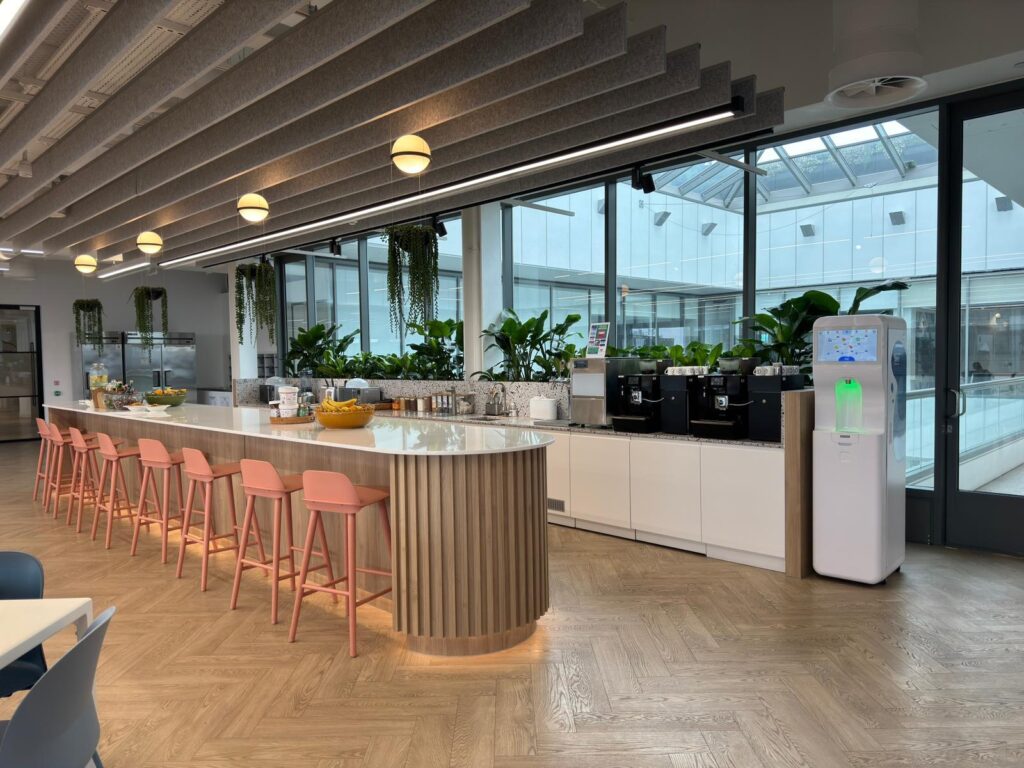
Bevi machine is a “must-have” for employee engagement at Dojo
Dojo is one of Europe’s fastest-growing payment companies that was founded in London in 2009. Its office headquarters can be found right next to Grand Union Canal in Paddington. Floor-to-ceiling windows let in plenty of light and sights. There’s a mix of comfy sofas with meeting rooms for all-day collaboration. The perfect place to work.
A standout feature of Dojo’s office culture is its emphasis on exceptional food and beverage amenities, including an on-site coffee barista. These amenities play a pivotal role in enhancing employee engagement and well-being. But the roster wasn’t complete. The missing piece: a water cooler that would bring the team healthy, functional beverages but way less plastic waste. Dojo has sustainability goals to achieve. And an office manager who isn’t looking to deal with plastic bottles.

“It’s easy to use, has a clean design, and aligns with our efforts to reduce plastic waste.”
—Brian Cromie, Dojo
“The Bevi water machine has been a fantastic addition to our office, offering both flavoured and sparkling water options that keep the team happily hydrated throughout the day,” said Brian Cromie, the head of workplace experience at Dojo. “It’s a must-have for any office looking to enhance their employee engagement.”
With a proven track record in the U.S., and buzz building in London and Dublin, Bevi is helping workplaces rethink how good water can taste.
Based in London (or Dublin)?
Read the latest on Bevi’s blog
- America Unfocused: Focus Struggles at Work Inspire Bevi to Launch Focus Blend
- Blog series: The rise of today’s iconic drink brands
- Vitamin Boost: Our most popular enhancement
- Every bottle counts: Beverage industry impact report
- These London-based companies love their Bevi machines
Last updated May 15, 2025.
Stainless steel water bottles are no longer functional products for hikers and gym-goers alone. They are mainstream lifestyle items, everyday essentials for maximizing the joy of hydration and minimizing the need for disposable (or reusable) plastic bottles.
What started as niche gear has exploded into a $9+ billion global industry, and the U.S. market has produced a revolving cast of reusable branded bottles over the last two decades, from Hydro Flask and YETI to Stanley and Owala. How do you tell them apart? What actually makes for the best stainless steel water bottle?
The short answer is somewhere at the intersection of form, function, and fashion. All the major players—Owala, Stanley, Klean Kanteen, YETI, Hydro Flask, and S’well—have cultivated loyal fans by finding their own unique territory in the overlap of that three-part Venn diagram.
Below, we break down what makes each stainless steel water bottle unique and how the biggest brands stack up.
The basics: what consumers want from their stainless steel water bottles
Whether someone’s shopping for a stainless steel water bottle that can survive a 10-hour hike, sit in a car all day without losing its chill, or just sit pretty on a desk, here’s what matters:
- Insulation that works. Most premium bottles today are vacuum-insulated to keep drinks cold for 24+ hours or hot for 12. According to consumer reviews and product tests, retention performance is often the first dealbreaker.
- Durability. A good stainless steel bottle should hold up over years of daily use. That includes no flavor retention, rust, or cracking paint after a few drops.
- Functionality. Leak-proof lids, wide mouths for easy cleaning, and drink options (straw, spout, flip top) tailored to user preference: these are the core ways consumers assess the best stainless steel water bottles to see if they’re easy to use.
- Design and personal style. Stainless bottles are now accessories. Consumers pick them based on colors, brand cachet, and how they’ll look on Instagram.
Owala: The fast-rising, highly-functional stainless steel water bottle disruptor
If you’re wondering why the phrase “Owala water bottle” is all over TikTok or the hashtag #owala has hundreds of millions of associated posts, here’s your chance to get caught up. A pastel-color phenomenon, Owala water bottles can be open, closed, and consumed with one hand thanks to their ergonomic design extending from bottle to cap.
Owala’s FreeSip bottle was named one of TIME’s Best Inventions of 2023 and became the top-selling water bottle in the U.S. by 2023 retail data.
What makes Owala water bottles so popular?
- Smart design: The FreeSip lid combines a built-in straw and chug spout, meaning you don’t have to choose between functions typically reserved for different products. For users who like options—or don’t like switching lids—it’s a massive upgrade. The bottle is also genuinely leak-proof and fits in most car cup holders.
- Performance: Owala bottles use triple-layer insulation to keep drinks cold for up to 24 hours. For hot liquids, the retention time is slightly shorter, but still competitive.
- Viral-friendly colorways: Owala’s bold color combos (like “Hyper Flamingo” and “Shy Marshmallow”) stand out in a sea of neutral-toned competitors. The brand doubled down on drops and limited editions that routinely sell out and even resell online for up to $400.
- Mass appeal meets Gen Z: Sales doubled year-over-year between 2022 and 2023, and social buzz helped it reach a broader base. According to Circana data, about 1.5% of U.S. consumers bought an Owala bottle in 2023—up from 0.8% the year before. Owala water bottles get nearly a million searches on Google every month. That’s some serious traction.
Why is it called Owala?
Owala has not publicly disclosed any information about the origin of its name. “We’ll keep that one close to the vest, but we sure love hearing everyone’s theories!” a company representative told Spoon University via email. Some TikTokers speculate it’s a play on the fact that you look like a koala head-on when the cap is flipped up and you’re drinking from the bottle. Others think the name is just fun to say.
Is Owala dishwasher safe?
According to the company’s website, the lid of an Owala water bottle can go in the top-rack of the dishwasher, the straw can go in the silverware bin, and the cups are best hand-washed to maintain their coating.
This bottle is for you if… you want a bottle that feels both fun and engineered for day-to-day convenience.
Stanley: From Grandpa’s thermos to social media’s favorite tumbler
The first Stanley product I bought was a flask, a keepsake for camping trips and bonfires on the beach. It came in the brand’s signature Hammertone green, though I didn’t know that was an iconic color at the time. The build quality was excellent, and over the past decade, the flask has held up, adventure after adventure.
Back when I bought that flask, Stanley’s website still looked like a workwear catalog. In just 10 years, the 110-year-old heritage brand has upped its appeal and exploded into mainstream drinkware lore thanks to a product built far tougher than my flask: a 40 oz. Quencher tumbler that can keep water cold even when everything around it is on fire.

- Insanely functional: The Stanley water bottle with straw—the Quencher—offers large capacity, a straw lid, and a handle that makes it easy to carry. It’s dishwasher-safe, fits in car cupholders, and keeps drinks cold for 24+ hours.
- TikTok gold: The rise of Stanley’s Quencher was largely influencer-fueled. Lifestyle vloggers, especially in suburban mom communities, made it part of their overall aesthetic. Demand skyrocketed. In 2023, Stanley’s water bottle sales surged to an estimated $750 million, up 87% from the previous year.
- Scarcity marketing: Stanley engineered hype with limited drops, creating waitlists of over 150,000 people and leading to resale frenzies after they went out of stock. This strategy helped grow Stanley’s U.S. market share to 15% by 2023.
- Refined design evolution: The 2023 Quencher update added recycled steel and improved leak resistance, reinforcing performance credibility alongside its style appeal.
This bottle is for you if… you want a statement-making tumbler that keeps drinks cold all day and has the hype to back it up.
Owala vs. Stanley
Stanley is currently the most dominant name in the space, a larger retail footprint and higher overall sales volume (although momentum is slowing).
Owala is a fast-moving upstart appealing to Gen Z with bold colorways and a unique lid design which may snatch away Stanley’s crown; Owala became America’s top-selling stainless steel water bottle in 2023.
At the end of the day, the choice is yours. Both bottles are remarkably well-designed, aesthetic, and can last forever with the right care.
YETI: The original premium player
YETI’s drinkware took off the same way its coolers did: by being virtually indestructible and over-engineered for performance.
- Durability first: YETI bottles and tumblers are built like tanks, often featuring extra-thick stainless steel walls and heavy-duty lids.
- Cold that lasts: Its double-wall vacuum insulation is some of the most effective on the market. Ice can last all day, sometimes longer.
- Not trendy, but timeless: YETI hasn’t had the viral glow of Stanley or Owala, but it continues to dominate among outdoor enthusiasts and those willing to spend for quality. As of 2023, it ranked third in Amazon’s water bottle sales by revenue.
This bottle is for you if… you want unmatched toughness and thermal retention with zero interest in fads.
Hydro Flask: Youth favorite turned stainless steel water bottle classic
Hydro Flask helped turn stainless steel into a fashion statement in the 2010s. With its powder-coated colors, wide mouth opening, and simple aesthetic, Hydro Flask became a top pick among students.
- Peak fame: Hydro Flask rode the 2018 to 2019 VSCO girl trend all the way to the top of U.S. sales.
- Broad appeal: It offers a wide range of sizes, cap types, and colorways. Its insulation is solid and reliable, even though it’s sealed with an alternative process to vacuum insulation.
- Declining growth: While still a key player, Hydro Flask’s share has dipped as Stanley and Owala climbed. It’s not as culturally dominant, but remains widely available and respected.
This bottle is for you if… you want a customizable bottle with a proven track record but don’t need it to be indestructible.
Klean Kanteen: The sustainability original
Klean Kanteen was the first to bring stainless steel water bottles to the U.S. market in 2004. It built its brand around sustainability and health.
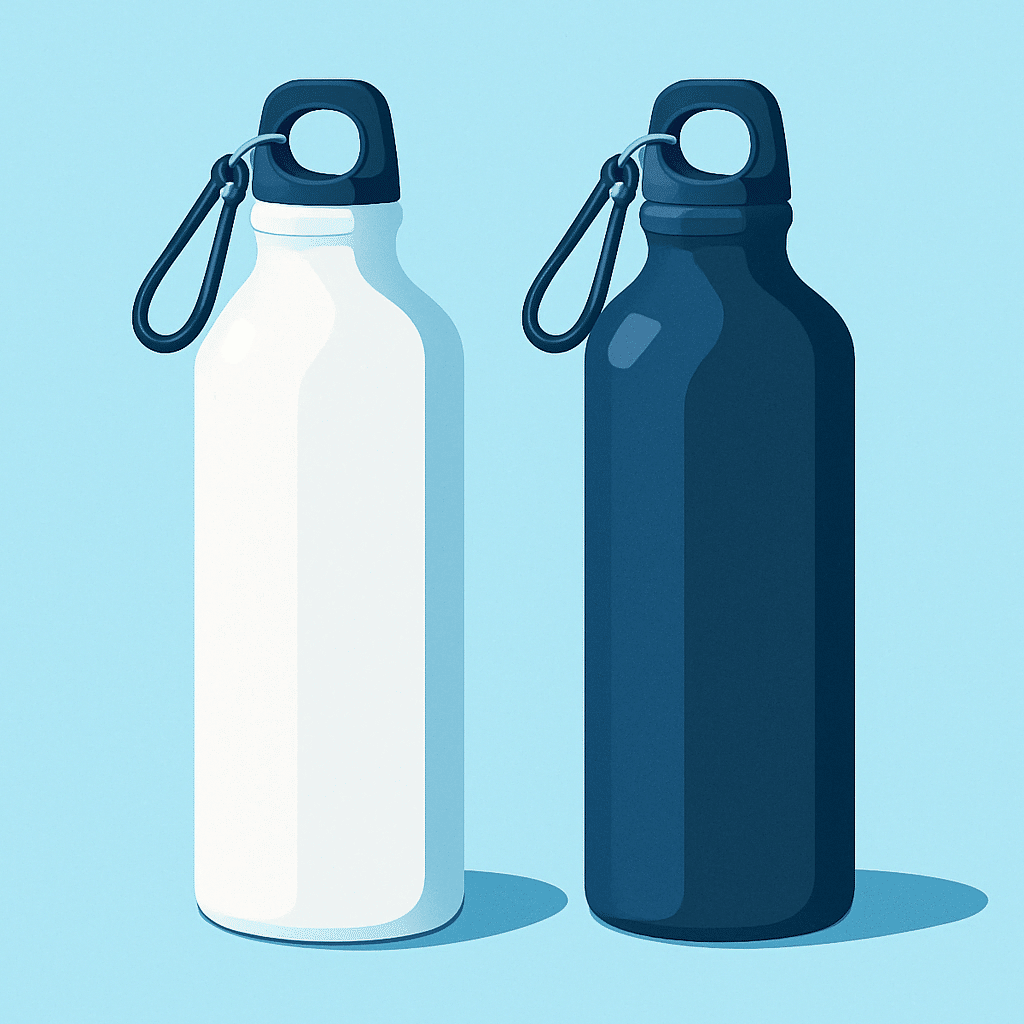
- BPA-free from the beginning: Klean Kanteen was created as an alternative to chemical-leaching plastic water bottles. Truly ahead of its time.
- Certified B Corp: The company focuses on ethical manufacturing and reducing environmental impact.
- Still niche: Beloved among eco-conscious consumers, it hasn’t played into social media trends and or carried the same market visibility.
This bottle is for you if… you want a simple and honest product with an eco-friendly history.
S’well: Where fashion met function
Founded in 2010, S’well pioneered the idea of the water bottle as a designer object.
- Slim, stylish, and office-friendly: S’well bottles fit into handbags and came in luxe prints and colors.
- Popularized hydration as fashion: In its peak years, it reached over $100 million in revenue.
- Past its peak: Newer brands with better insulation and stronger digital presence have surpassed it. Today, S’well focuses more on partnerships and custom orders.
This bottle is for you if… you want something elegant, compact, and a little under-the-radar.
Final thoughts: The best stainless steel water bottle depends on you
Every stainless steel bottled brand mentioned here has succeeded by answering a different consumer need. If you want trend-right color drops and a lid that lets you sip or chug, Owala might be the move. If you want a giant, handled, straw-topped bottle that keeps drinks cold no matter what, Stanley’s hard to beat. YETI’s for those who want rugged reliability; Hydro Flask for classic utility; Klean Kanteen for sustainability; S’well for understated style.
One thing they all share: they’re making it easier—and cooler—for people to ditch plastic and stay hydrated.
The best stainless steel water bottle is the one you actually want to use every day. Bevi is proud of you, the reader for choosing a sustainable drinking options vs. a single use water bottle!
Read the latest on Bevi’s blog
- America Unfocused: Focus Struggles at Work Inspire Bevi to Launch Focus Blend
- Blog series: The rise of today’s iconic drink brands
- Vitamin Boost: Our most popular enhancement
- Every bottle counts: Beverage industry impact report
- These London-based companies love their Bevi machines
Poppi soda started as a kitchen experiment with apple cider vinegar. Today, it’s winning over consumers and answering the call for functional ingredients in a sugar-saturated soda category that’s slipping away from the biggest names in beverage.
Last updated April 15, 2025.
For decades, soda held a fixed place in American life. Cracking a cold can. The fizz. That first sip. Aaaaahhhh. It’s a beverage that’s tied to memories as much as the meals we drank it with. The taste of summer barbecues, long road trips, movie nights. Sweet indulgence.
But soda has, in the last three decades, especially now in light of prebiotic Poppi soda getting acquired last month for $1.95 billion, undergone a change. The warm, familiar glow of classic soda brands has dimmed. Growing concerns about sugar overload, artificial sweeteners, and an utter lack of nutritional value have made even the most devoted soda fans second-guess their nostalgic choices.
One door opens as another closes. Brands like Poppi soda and its fiber-forward counterpart, OLIPOP, have pioneered a new healthy soda category with purported functional benefits. Poppi, in particular, has become a breakout beverage and is on its way to being a household name.
How legacy soda brands lost control of their category
For decades, soda giants sat comfortably atop the beverage world. The formula seemed unshakable: deliver big, bold flavors, anchor them in iconic branding, and keep consumers coming back for that sweet, carbonated hit of Americana.
Then, we learned the cane sugar in soda ain’t so sweet. Starting in the late 1990s, studies linked sugary drinks to weight gain, fueling growing concerns about health risks, such as obesity and diabetes, from excessive soda consumption. The sugary, fizzy beverage shifted from comfort to liability. Familiar favorites became harder to justify. Consumers started buying fewer soda bottles.
The modern health movement in America also picked up in the early 2000s, contributing to this decline in soda sales. People began paying closer attention to what they were eating and drinking. They wanted to understand, increasingly, the origins of their food. Food tracking apps, clean-label packaging, and clean eating philosophies pushed ingredient transparency to the forefront.
What’s in this drink? How is it helping my health?
Soda consumption in the U.S. fell from nearly 53 gallons per person annually in 1998 to below 39 gallons by 2018—a 26% decline in just two decades.
Legacy soda brands fumbled their response. They doubled down on diet versions, amping up the relative safety of artificial sweeteners. But this solution quickly soured. Research raised new alarms about potential health risks tied to those very sweeteners, such as increased risks of heart attacks and strokes.
Consumer trust eroded further, and brands like Coke and Pepsi found themselves caught in a trap. Wary of changing their flagship formulas, yet hesitant to launch truly innovative new products, they largely chose to acquire other beverage brands rather than invent.
Late-millienials and early-Gen Z let the soda go flat
Younger generations were kicking the classic soda habit the most. Between the mid-2000s and late 2010s, teen soft drink consumption plummeted by nearly 60%. Surveys confirmed that this move away from traditional sodas was an intentional search for beverages that better aligned with their personal values: natural ingredients, functional benefits, and health-forward choices.
In that vacuum, sparkling water found its moment. LaCroix, once a little-known regional player, skyrocketed from $65 million in 2010 to over $226 million by 2015—a meteoric 247% rise. Spindrift followed suit, experiencing a remarkable 800% growth between 2016 and 2018.
But even as sparkling water began pulling share from Big Soda, a bigger opportunity was quietly forming on the horizon. Functional sodas—the answer to consumers craving the fun and flavor of their terrible-for-you fizzy drink, reimagined to be better-for-you—started to take shape. Today, these low-sugar, functional-ingredient-laden sodas claim about 2.7% of the U.S. carbonated beverage market, with projections suggesting the category could surge toward $2 billion in sales by 2029.
Which raises a fascinating question: how did this all happen so fast? How did soda—a category once defined by its sugary excess—get flipped on its head and reinvented as a functional, feel-good staple?
To answer that, let’s start at the beginning. Specifically, in a home kitchen in Texas, where a determined founder took a vinegar-based home remedy and sparked a beverage revolution.
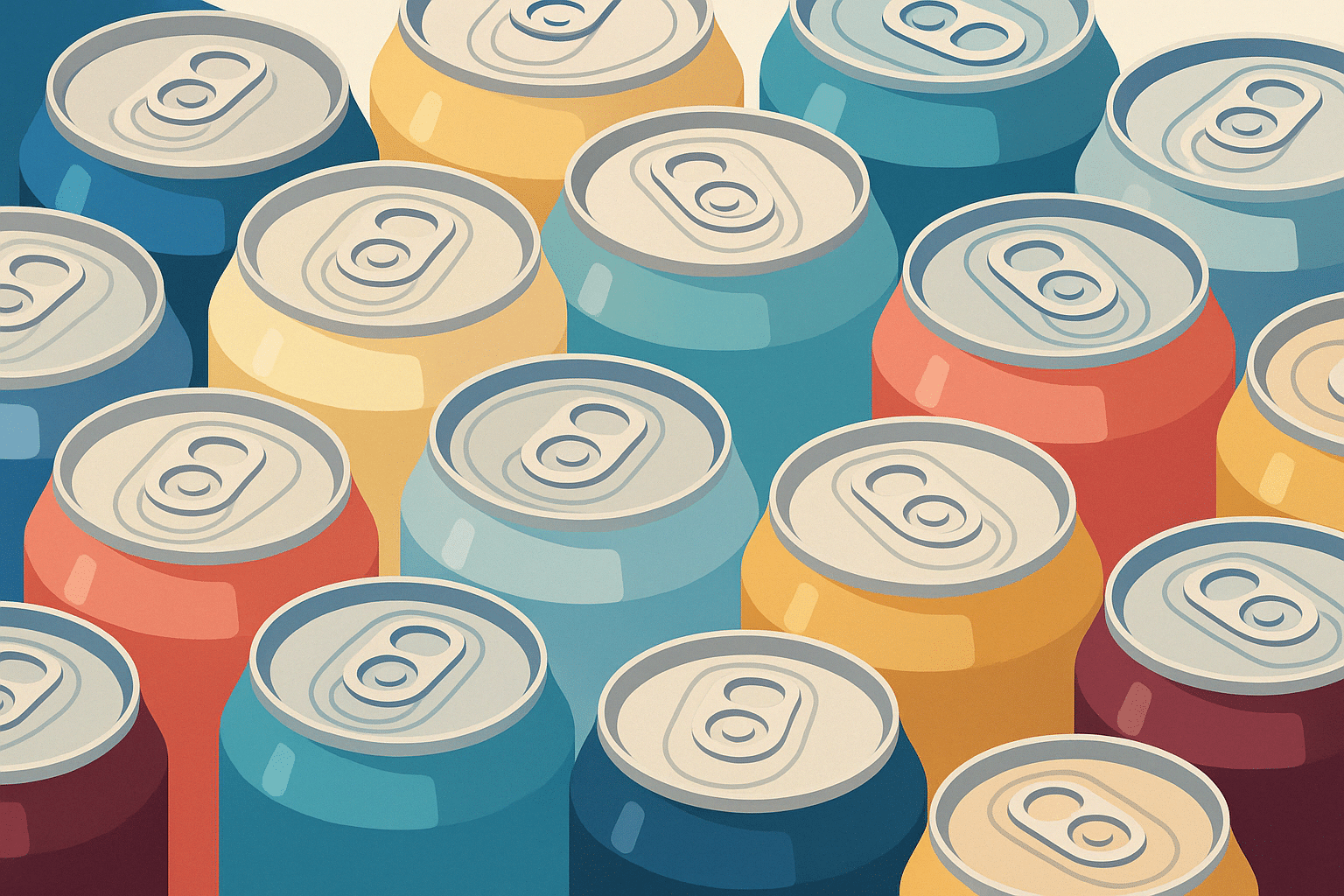
Poppi soda 1.0: From home remedy to Shark Tank gamble
Allison Ellsworth was battling persistent health issues and searching for natural remedies that worked. She stumbled upon apple cider vinegar (ACV), lauded for its high acetic acid content, known to help lower blood sugar and combat harmful bacteria in the body. Determined, she began taking daily shots of the acidic elixir. But as anyone who’s tried a straight shot of ACV knows, it’s an eye-watering experience—harsh on the throat and tough on the stomach lining.
Ellsworth believed deeply in the health potential of ACV, particularly the mysterious “mother” substance found in unfiltered vinegar; a cloudy collection of proteins, enzymes, and friendly bacteria that some consider the secret to ACV’s health benefits (though clinical proof remains limited). She and her husband Stephen set out to solve the problem: how could they preserve the benefits of ACV but make it drinkable, maybe even refreshing?
Through plenty of trial and error, they created a prototype that blended ACV with fruit juices and natural sweeteners to tame its aggressive bite. What they developed exceeded expectations. It was a bright, slightly tart, and genuinely refreshing beverage that delivered health perks without the vinegar sting.
In 2018, the Ellsworths took their fledgling drink, then branded as Mother Beverage, to Shark Tank. Most of the Sharks were unimpressed, visibly recoiling at the vinegar-forward flavor. But one saw beyond the pucker. Rohan Oza, the brand-building force behind Vitaminwater and Bai, asked, “Do you have a functional story?” Oza understood that a beverage’s success wasn’t just about taste. It was about what people believed drinking the beverage would bring them. Health. Wellness.
Taking a chance on the gut-friendly concoction, Oza invested at a $1.6 million valuation for a 25% stake in the company. Little did he know, this would become the highest ROI investment in Shark Tank history: seven years later, Poppi’s sale to PepsiCo at a $1.95 billion valuation has the potential to transform his early investment, should his shares have remained undiluted, into a nearly $500 million stake in the future of soda.
Still, in its early Mother Beverage days, this was just a scrappy kitchen project with a dedicated following. Not a cultural icon (yet). That part was still to come.
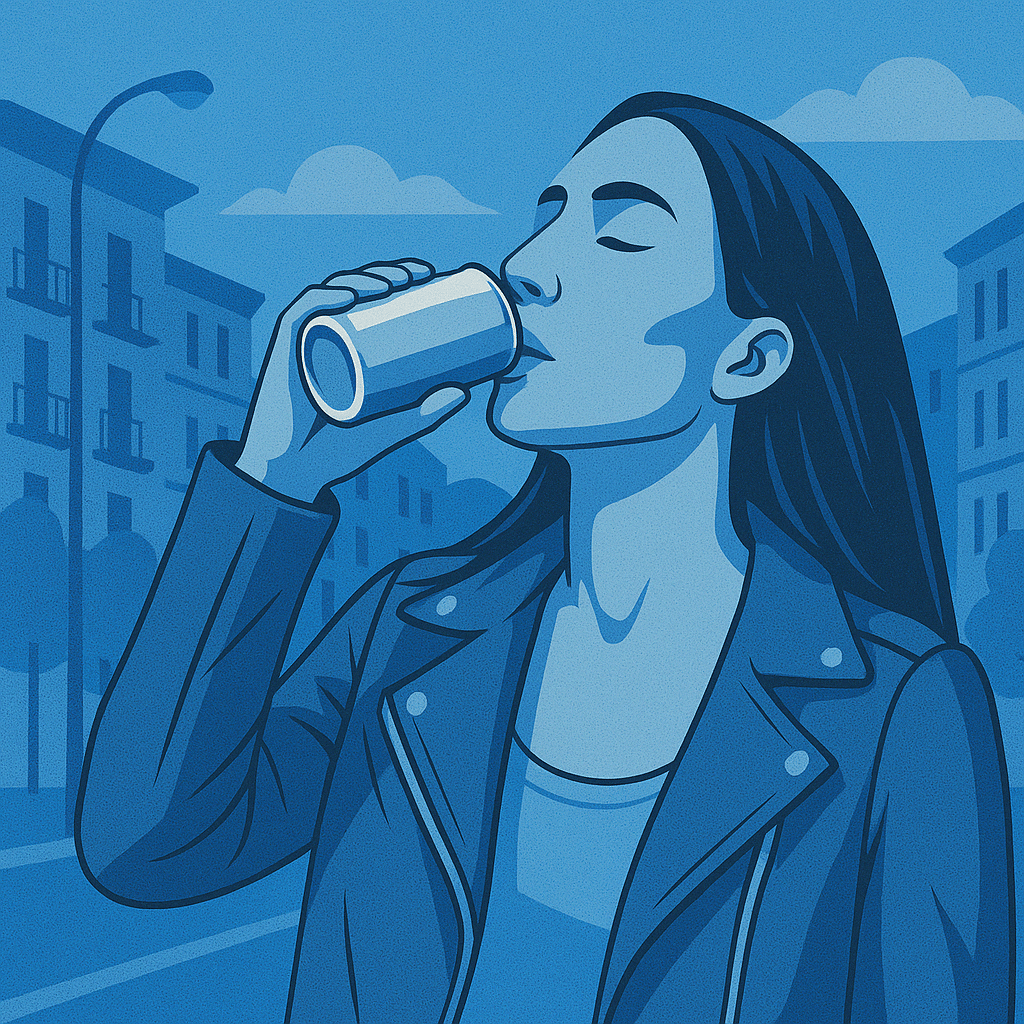
Poppi 2.0: Reinventing soda for the wellness generation
Following Shark Tank, the founders realized Mother Beverage needed more than a functional story—it needed a cultural one. That’s where they turned to Poppi: a name change that perfectly captured the brand’s fizzy, approachable personality and helped distance it from the vinegar-heavy health tonic perception.
The rebranding was much more than cosmetic. The team amplified everything that made their drink feel fresh and fun. Out went the apothecary-style branding of Mother Beverage; in came candy-colored cans, sun-soaked pastel palettes, and cheeky, irreverent tone. Poppi quickly became Instagram gold, with influencers flaunting rainbow-hued cans in sun-dappled kitchens and beachy picnics. The visuals alone screamed: this is not your mother’s health drink.
Poppi’s playbook was smart: pair wellness with whimsy. Flavors like Strawberry Lemon and Raspberry Rose delivered nostalgic nods to soda classics, but with none of the sugary baggage. Each can packed a modest 20 calories, around 5 grams of sugar, and a dash of ACV, giving it the credibility of a functional beverage without overwhelming the palate.
The strategy worked. Poppi’s growth exploded: sales crossed $50 million in 2021 and doubled to around $100 million by 2023. The company reported 148% year-over-year growth in 2022 alone as it expanded into major retailers and carved out space next to kombuchas and sparkling waters on supermarket shelves.
The culmination of Poppi’s meteoric rise came in March 2025, when PepsiCo acquired the brand for nearly $2 billion. This move sent shockwaves through the beverage industry because it validated the entire “better-for-you soda” category. Big Beverage had made it clear: functional fizz is the future.
Yet even in the glow of its success, Poppi’s journey is more revealing than it is triumphant. The brand’s ascent underscores the cultural craving for drinks that do more than quench thirst. Consumers today want beverages that reflect their values: wellness-oriented, visually joyful, and socially shareable.
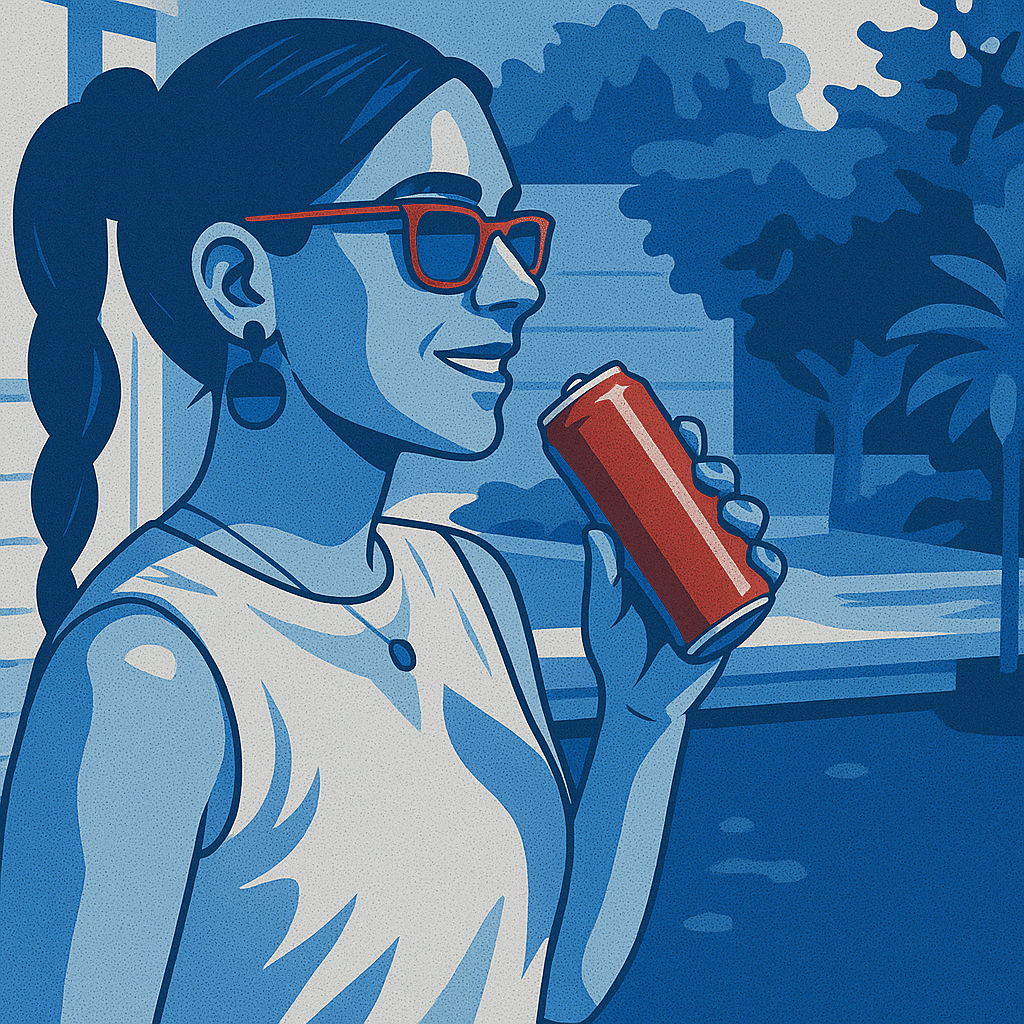
OLIPOP soda enters the chat: the fiber-forward challenger
Poppi may have captured the cultural zeitgeist with its Instagram-worthy aesthetic, but it’s far from the only innovator redefining the soda aisle. Enter OLIPOP, a brand that took a more scientific route to soda reinvention, proving there’s more than one way to stand out and gain market share in the better-for-you soda moment.
Founded by functional beverage veterans Ben Goodwin and David Lester, OLIPOP’s story begins in the lab. Both founders were deeply invested in the science of gut health and the gut microbiome long before it became mainstream dinner party conversation. Their mission was to create a drink that supported digestive health while tasting indulgent enough to tempt even the most committed cola drinker. Great for your body, great for your tastebuds.
The key to walking this fine line? Fiber.
Fiber is one of the most important nutrients for long-term health and longevity, helping to maintain digestive health, regulate blood sugar, and even lower cholesterol levels. In fact, dietary fiber is so essential that experts regularly cite it as a cornerstone of preventative nutrition.
Each can of OLIPOP soda boasts about 9 grams of dietary fiber per can: that’s roughly a third of the daily recommended intake, stealthily packed into flavors like root beer and cream soda that recall our soda shop favorites. OLIPOP’s fiber boost comes from an impressive roster of plant-based ingredients: marshmallow root, slippery elm, chicory root, cassava fiber, and more—all ingredients more at home in a naturopath’s apothecary than your average vending machine.
OLIPOP soda puts strategy on a shelf
But OLIPOP’s success isn’t just rooted in its ingredient list. It’s in the way the brand has smartly mapped its growth strategy around consumer behavior and retail expansion. While many brands scrambled to build direct-to-consumer social media or digital channels during the pandemic, OLIPOP kept to a retail-first approach. They strategically targeted natural food retailers and quickly expanded into mainstream heavyweights like Whole Foods, Target, and Kroger. By 2023, they had earned shelf space in over 20,000 stores nationwide, jumping from easy-to-miss specialty sections to aisle endcap displays.
This expansive retail footprint paid off handsomely. In 2023, OLIPOP surpassed $200 million in sales. By 2024, their revenue had doubled to nearly $400 million. Unlike brands that rely heavily on social buzz or digital channels, OLIPOP built its foundation on strong physical presence, ensuring consumers could discover their products while shopping for everyday essentials.
That said, OLIPOP has skillfully complemented its retail dominance with a clever dose of cultural relevance. Like Poppi, they’ve embraced social media to amplify their reach, using influencer partnerships and TikTok-friendly campaigns to draw in younger, health-conscious audiences. But where Poppi plays in bright, breezy spaces, OLIPOP exudes an intellectual charm, appealing to label-readers and wellness seekers who appreciate both nostalgia and nutritional rigor.
And while both brands champion gut health, OLIPOP distinguishes itself with its depth of scientific validation. By clinically supporting their formulation and staying true to their functional roots, they’ve built a playbook for the next generation of better-for-you beverages—drinks that don’t just promise wellness, but deliver it.
While Poppi and OLIPOP take different paths to gut health, they’re united by a common goal: reinvent soda for the wellness generation.

OLIPOP vs. Poppi: competitors or co-creators of a category?
It’s tempting to pit Poppi and OLIPOP against each other in a “healthy soda showdown,” but the reality is far more collaborative. Together, they’ve built the scaffolding of an entirely new beverage category—one that’s big enough for both to thrive.
- Ingredients: Poppi leans on apple cider vinegar for its prebiotic benefits, while OLIPOP uses a hefty blend of plant-based fibers and botanicals.
- Flavors: Both brands pay homage to classic sodas with flavors like Cola and Lemon Lime, but OLIPOP dives deeper into fiber-rich blends, while Poppi keeps things bright and approachable.
- Health claims: Both promise digestive health perks, low sugar counts, and better-for-you positioning—but their approaches appeal to slightly different audiences. Poppi’s playful marketing resonates with the casual health-curious crowd, while OLIPOP’s fiber-forward formula may attract more label readers and wellness devotees.
What’s remarkable is how these two brands have collectively validated the healthy soda category. By addressing consumer desires for flavor, nostalgia, and functionality, they’ve proven there’s robust demand for soda alternatives that don’t sacrifice health goals.
Looking ahead, their success is likely to inspire a new wave of functional sodas and hybrid beverages. Expect everything from sodas infused with adaptogens to hydration-boosting bubbles with added electrolytes. There’s plenty of fizz to go around.
What Poppi soda and OLIPOP tell us about the future of soda
Poppi soda and OLIPOP soda are signals of a shift in the beverage landscape. Consumers today are no longer satisfied with low calorie or diet alone. They expect their drinks to work harder: to taste great, support their health goals, and deliver a delightful experience from the first sip to the last bubble.
These brands have tapped into something deeper than just a trend. They’re reshaping soda into a functional, feel-good moment of joy—without the sugar crash. They’ve made the act of cracking open a can something you can feel genuinely good about.
What does this tell us about the future of soda? The soda aisle of tomorrow will look much of the same, bright colors and fun flavors, but what’s underneath the label will be totally different.
Mini-FAQ
Is Poppi soda good for you?
Poppi offers a lower-sugar alternative to traditional soda, with prebiotic benefits from apple cider vinegar, but like any beverage, it’s best enjoyed as part of a balanced diet. As demand for gut-healthy sodas grows, a recent lawsuit against Poppi sodas challenges whether a few grams of fiber are enough to justify the claim that beverage company makes on each one of their cans.
Who owns Poppi soda?
As of 2025, Poppi is owned by PepsiCo, following their nearly $2 billion acquisition.
Does Poppi soda have caffeine?
Most Poppi flavors are caffeine-free, though their Classic Cola and Root Beer varieties contain small amounts of natural caffeine.
Is OLIPOP good for you?
OLIPOP is designed to support digestive health, with 9 grams of dietary fiber and a blend of botanicals, making it a better-for-you soda option when enjoyed in moderation.
Does OLIPOP have caffeine?
Some OLIPOP flavors, like Vintage Cola, contain a modest amount of caffeine, while most are caffeine-free.
Read the latest on Bevi’s blog.
- America Unfocused: Focus Struggles at Work Inspire Bevi to Launch Focus Blend
- Blog series: The rise of today’s iconic drink brands
- Vitamin Boost: Our most popular enhancement
- Every bottle counts: Beverage industry impact report
- These London-based companies love their Bevi machines
March 31, 2025. One of the best things about flavored water is simple: people drink more of it. A clean citrus note, a splash of melon or berry—it helps the glass go down faster, and makes you want another. In fact, 82% of people say flavors make water more palatable and interesting. And when you drink more water, you stay better hydrated, which means clearer thinking, better mood, better days.
But is flavored water good for you? Not just more enticing to drink?
That depends on three things: the quality of the water itself, the ingredients responsible for the flavor, and how much of it you’re drinking.
If you’re trying to figure out whether that new bottle in your hand is worth drinking—or if your flavored water habit is helping or hurting—here’s a thee-point checklist to run through.
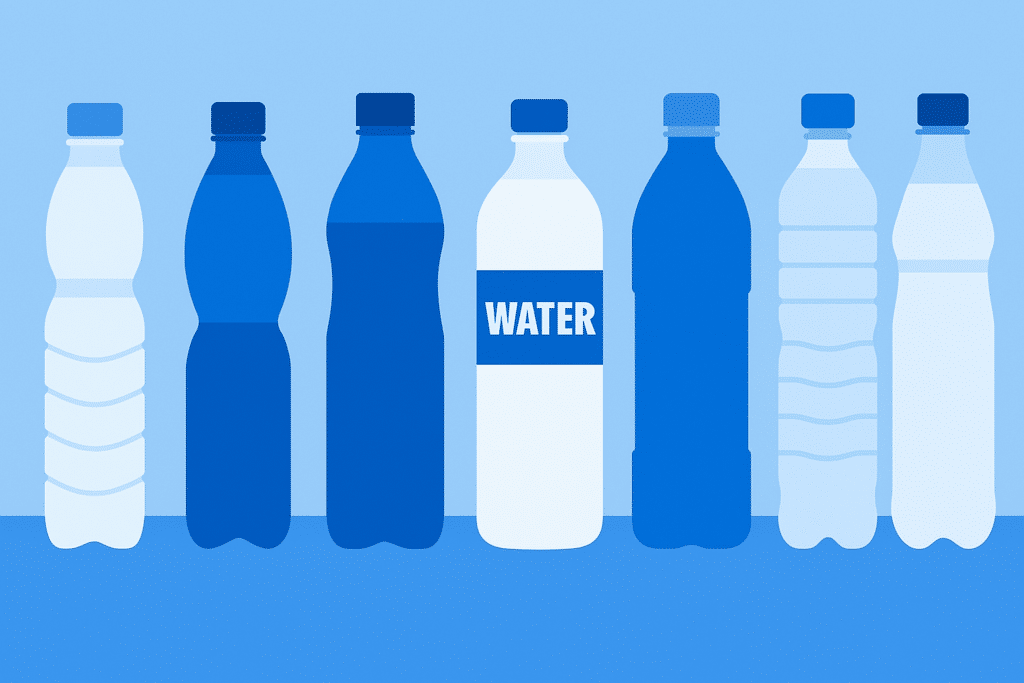
1. How is the flavored water packaged?
The vessel matters more than most people realize. It’s not just what’s in the water; it’s what the water’s been sitting in.
Plastic bottles
If you’re getting flavored water from a single-use plastic bottle—no matter the quality of that plastic—there’s likely thousands, if not hundreds of thousands of plastic particles floating around in the water. Plastic beverage bottles break down a lot between the time it’s packaged to when it’s consumed.
Aluminum cans
While recyclable, aluminum cans have been found to contain higher concentrations of endocrine-disrupting chemicals, such as bisphenols, compared to other packaging materials. These substances leach into the flavored water.
No packaging at all
If you’re getting flavored water dispensed to you, right into your reusable cup, glass, or reusable water bottle, after it passes through a high-quality filter, you can dramatically minimize exposure to these nasty contaminants associated with packaged beverages.
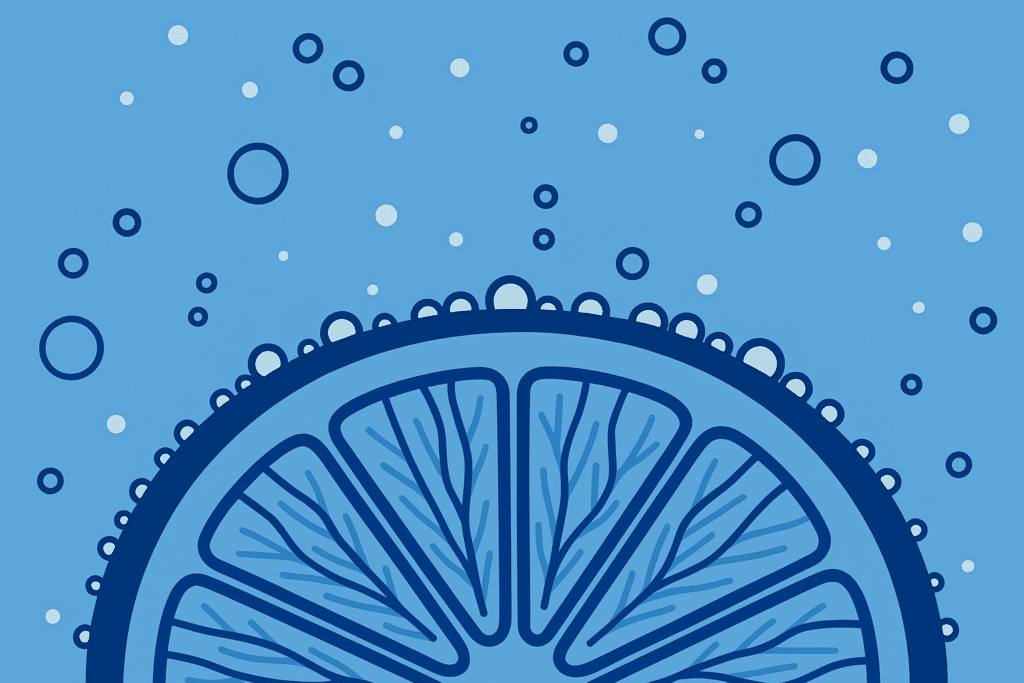
2. What’s giving it that flavor?
When you’re looking at a bottle of flavored water, don’t just scan the calorie count—look at the ingredients.
- Real fruit juice or fruit infusion: This is your best-case scenario. Simple ingredients you recognize.
- Natural flavors: Often extracted from fruit via vapor or solvents. Less transparent than real juice, but a reliable way to get a subtle and refreshing flavor that travels well and has a more respectable shelf life.
- Artificial flavors: If the ingredient list starts reading like a chemistry experiment, that’s your cue to put it back down. You shouldn’t need a search engine to understand what you’re drinking.
Now check for sweeteners.
- Too much sugar: Even if it’s “natural” (like cane sugar), the total amount matters. A few grams? Fine. A few bottles a day at 15 grams a pop? You’ve wandered into soda territory.
- Artificial or zero-calorie sweeteners: Stevia leaf, erythritol, sucralose: as far as natural or artificial sugar substitutes, it’s best to approach both in moderation. That being said, opting for a natural sweetener over an artificial one is, well, more natural.

3. How much are you actually drinking?
Daily intake changes the answer to whether flavored water is good for you.
If it’s sweetened—naturally or artificially, consider both along the same line—keep your flavored water intake to a moderate amount. If it’s unsweetened, you’ve got more freedom. The safest bet is flavored water made with clean, real ingredients.
Bevi’s flavors, for example, are naturally derived from real sources like fruit. All but two come with no added sweeteners or calories.
For some people, adding flavor is the only way to drink enough water each day. If that’s you—and you’ve checked off the first two items on this list—then drinking plenty of it makes sense.
So, is flavored water good for you?
It can be. It often is. Especially if the ingredients are clean, the packaging is safe. Like most things: it’s about the context, the inputs, and the quantity.
Flavored water can be a way to make drinking water feel less like a chore. Use this list to make sure it’s not your health doing the extra work.
Read the latest on Bevi’s blog.
- America Unfocused: Focus Struggles at Work Inspire Bevi to Launch Focus Blend
- Blog series: The rise of today’s iconic drink brands
- Vitamin Boost: Our most popular enhancement
- Every bottle counts: Beverage industry impact report
- These London-based companies love their Bevi machines
Last updated July 2, 2025.
With plastic particles showing up everywhere—in our food, our drinks, even the air we breathe—you might be wondering: is there any bottled water without microplastics?
If you drink water from a plastic bottle, you are drinking plastic.
Not fear-mongering. Not hyperbole. Not facetious. Fact.
How? All plastic degrades. As it degrades, it sheds. Plastic sheds from the moment your water is bottled to when it shows up on the store shelf. Plastic from a standard single-use, liter-sized bottle sheds. Tritan copolyester, a more durable type of plastic used to make popular reusable water bottles, like Nalgene’s iconic 32 oz. wide mouth, sheds. (If you wash your reusable plastic bottle in the dishwasher, the heat and water pressure will cause it to shed even more the next time you fill it up.)
Yes, even your reusable plastic bottle adds microplastics to your water.
As your reusable plastic bottle is jostled around in your backpack, heated up by the sun, and plopped onto your kitchen table, another round of imperceptible plastic pieces are knocked loose.
For real, even cracking the lid on a bottle of water releases more microplastics into your beverage.
This isn’t a marginal amount of shedding. According to research released in January 2024, a single one-liter plastic bottle of water contains 240,000 plastic particles. For context (and this is wild context), back in 2018, research conducted with still fairly state-of-the-art imaging technologies identified only 325 plastic pieces in a liter bottle. Still a lot of plastic, yes, but a staggering 739 times less than what we’re actually getting in that volume of water.
And it’s not that the material is deficient, that the plastic used for single-use bottles got worse. It’s that the tools for imaging plastic particles in the water from a plastic bottle got more advanced and more able to pick up on exceptionally small pieces, known as nanoplastics, along with the slightly-bigger-but-still-so-so-small microplastics.
If the detection has improved this much in seven years, what do you think we’ll be seeing in another seven?

BPA-free, dye-free, recyclable, spring, distilled, alkaline, any kind: If it’s coming from a plastic bottle, the water has microplastics in it.
While research is still catching up, early studies suggest that microplastics could contribute to inflammation, hormone disruption, and even immune system impacts. You probably don’t want to until the long-term effects of drinking bottled water are known for certain, right? Better to cut it out now.
What about aluminum bottles? Do they have microplastics too?
Aluminum and glass bottles are a step in the right direction. Since they’re not made of plastic, they won’t shed plastic into your drink. But they can’t completely solve the problem either, since the filtration methods used to bottle or can any kind of water for single-use—whether plastic, aluminum, or glass—is likely not up to par with what you want to be putting in your body.
Studies have found that tap water contains a number of microplastics, which is bad news for bottled water. Because, well, bottled water is mostly overpriced tap water. The leading bottled water brands—including Coke’s Dasani and Pepsi’s Aquafina—are nothing more than municipal tap water run through a filter that is likely not adequate for removing these plastic particles.
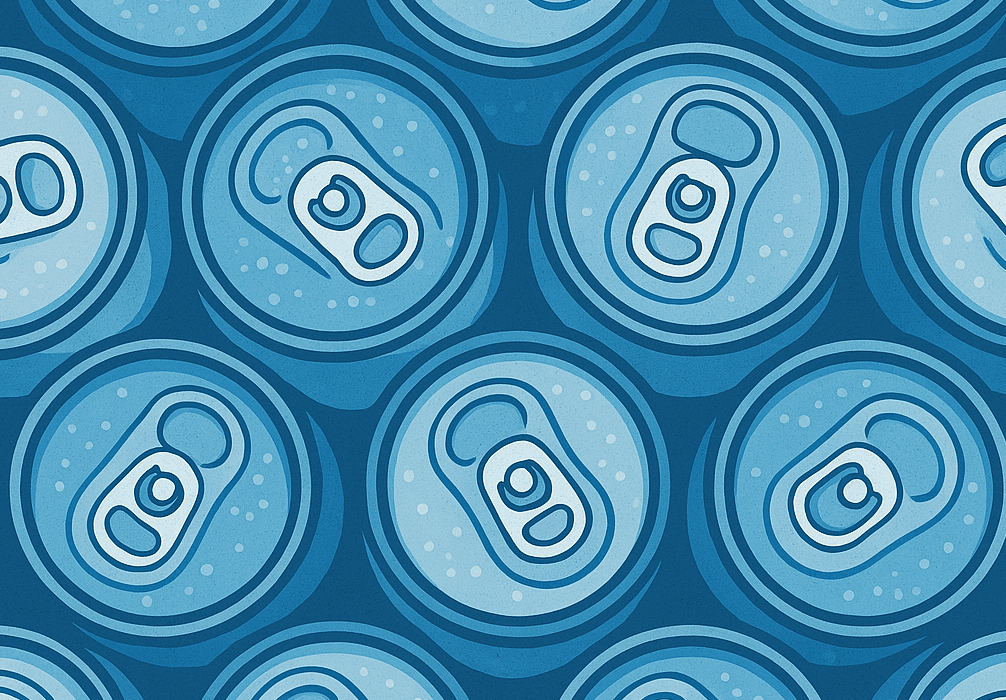
The bigger picture. Also worth mentioning that, even if aluminum and glass single-use bottles cut down your exposure to microplastics, they still carry an environmental cost. Mining. Manufacturing. Transport. Refrigeration. And despite all the “infinitely recyclable” claims, most of these bottles end up as litter, in landfills, or washing away into our waterways, going along a potentially length but inarguably inevitable journey to the ocean.
So what’s the solution to this microplastics problem? Filter water at the source. Bottle it yourself.
Disposable water bottles may be a dead end, but the trip’s not over. There’s a different on-ramp you can take instead. You stop buying the problem in a container. You filter water at the source. You pour it into your own reusable stainless steel bottle. You never look back.
Find the right filter. High-quality water filtration is your first line of defense against microplastics. Most basic filters do an okay job—they take the edge off the chlorine, maybe improve the taste—but they’re not built to deal with what we’re facing now: microplastics, nanoplastics, the invisible grit that’s made its way into one of the most essential thing we consume.
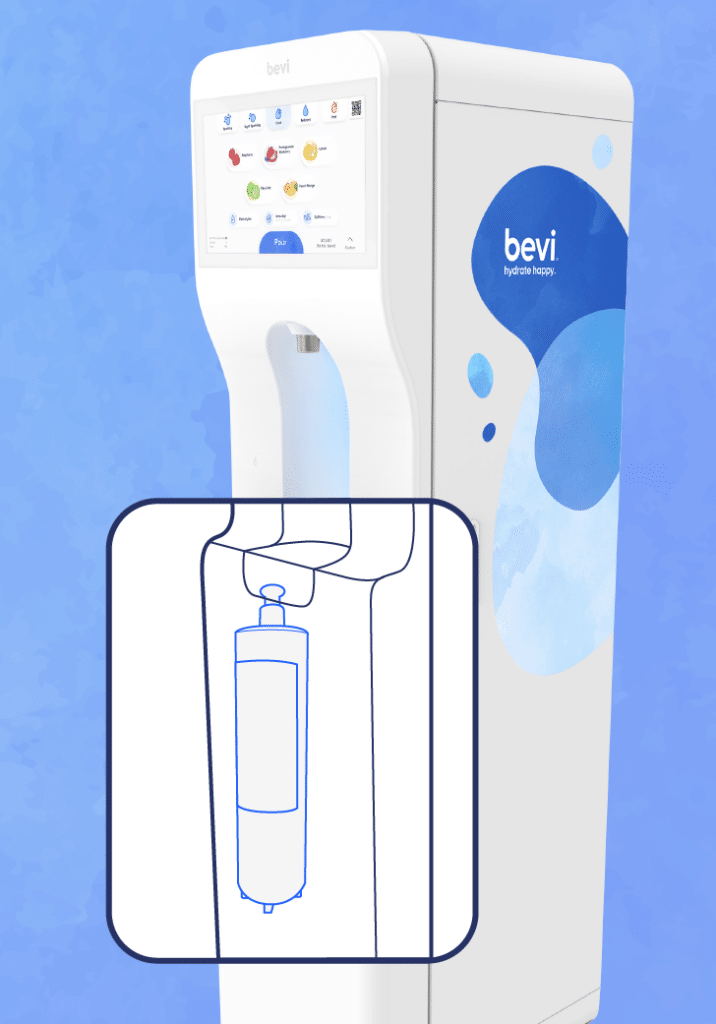
That’s why Bevi water cooler machines were designed the way they were, with an advanced filtration system that houses a recommended, commercial-grade carbon filter certified to remove 99.9% of microplastics from tap water. Every gallon of Bevi water you drink instead of bottled water saves your body from ingesting an average of 900,000 plastic pieces. Not bad, as they say.
When you don’t have access to a Bevi machine at work, the gym, the cafeteria, or the brewery, and you’re at home looking for a glass of water, you can turn to a premium pitcher with a replaceable filter. LifeStraw makes a (relatively) affordable at-home filtrating pitcher that can remove not only microplastics from your drinking water, but a range of other chemicals and heavy metals.

How to make your hydration setup truly plastic-free:
- Look for the certification: Not all filters remove microplastics. Find one that’s certified for its removal, like those filters that Bevi recommends for use in our water coolers.
- Source wisely: When on the go, choose hydration stations with proven filtration, like Bevi machines, instead of opting for water that’s bottled in plastic.
- Go stainless steel or glass for your bottle: These materials don’t leach or degrade like plastic. Also, make sure you’re using reusable bottles most of the time.
- Make it last: Treat that reusable bottle like it’s an extension of yourself and wash it by hand regularly, preferably daily. Consider it a fundamental part of your everyday carry, like a phone, wallet, or set of house keys. And treat yourself to filtered water every day.




